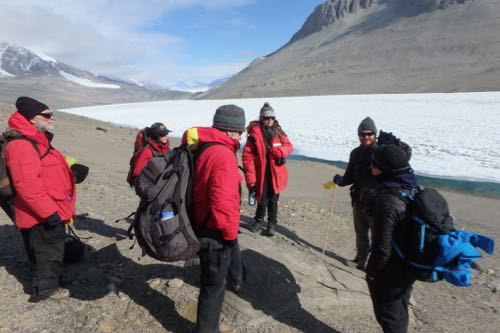This morning, our team climbed aboard a Bell 212 helicopter and took a 50-minute flight over McMurdo Sound, headed for the Dry Valleys. We passed several seals, penguins, and about 20 orcas on the edge of the sea ice. We entered the Dry Valley area. The area is starting to look familiar. We flew by the Commonwealth GlacierA mass of ice that persists for many years and notably deforms and flows under the influence of gravity. where we performed our P3 experiment last week. We saw the massive Canada GlacierA mass of ice that persists for many years and notably deforms and flows under the influence of gravity. that overlooked the Lake Fryxell Camp (where I spent a few days previous). After another 10 minutes of flying up the valley, Lake Bonney was spotted where I spent four days working with the ice divers looking at the floor of this lake where it was just loaded with life. We landed back at Lake Bonney and made a plan on how we would get our SLIME experiment taken care of for the day.

SLIME stands for the soil-lake inundation moat experiment. Dry Valley LTER (Long Term Ecological Research) teams collaborate on this experiment. Transect plots are set up. Samples are taken and life analyzed from the soil above the water-line, in the moat (area between the shore and lake ice), and out into the lake (which is what the divers were doing – who I was with this past week). All data will be shared and compared, attempting to put together more pieces to the "life in Antarctica" puzzle.
Here is a video showing our flight in to Lake Bonney this morning. If you look super close, you can spot a few orcas we flew past and a few penguins. It's hard to see, but I did my best with my GoPro without a zoom. You will see several glaciers and beautiful blue frozen lakes. We then hike to our SLIME site. Beautiful Dry Valley landscape. Enjoy.


Comments